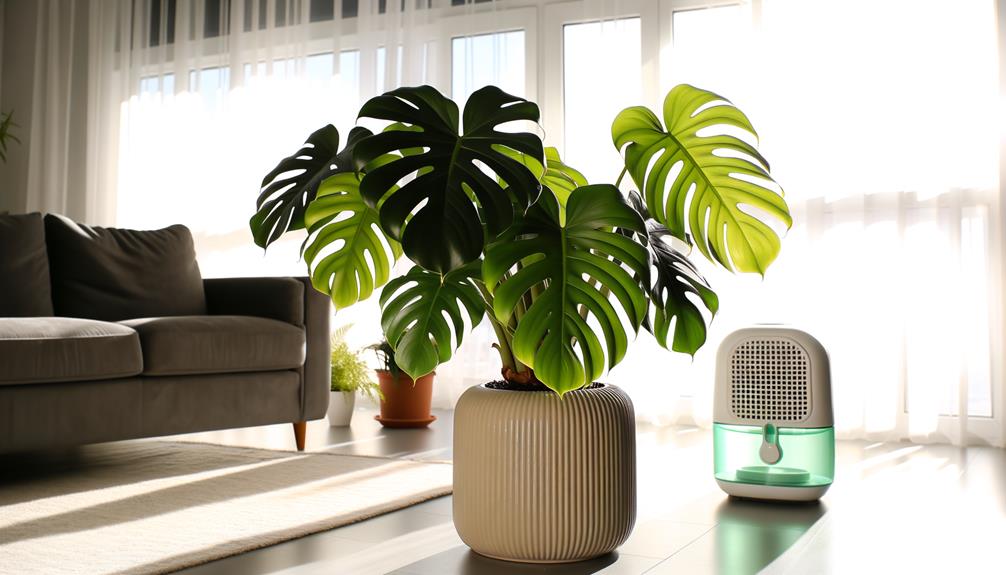Monstera Peru Indoor Care Tips
To care for your Monstera Peru indoors, position it in bright, indirect light, ideally near a north or east-facing window. Water when the top inch of soil is dry and use well-draining, nutrient-rich soil.
Maintain temperatures between 65-80°F and humidity levels at 60-80%. Fertilize every 4-6 weeks with a balanced N-P-K ratio, diluted to half strength.
Regularly inspect for pests like spider mites and mealybugs, using neem oil for control. Proper light, water, and pest management are essential for robust growth.
Learn how to fine-tune these elements for best plant health.

Key Takeaways
- Place Monstera Peru in bright, indirect light near a north or east-facing window.
- Water the plant when the top inch of soil is dry and ensure good drainage.
- Maintain a temperature range of 65-80°F and humidity levels of 60-80%.
- Apply a balanced N-P-K ratio fertilizer every 4-6 weeks, diluted to half strength.
- Regularly inspect for pests and use neem oil or insecticidal soap for control.
Ideal Lighting
For ideal growth, Monstera Peru requires bright, indirect light, mimicking the dappled sunlight of its natural rainforest habitat. You should place it near a north or east-facing window to make sure it gets ample luminosity without direct exposure.
Direct sunlight can cause photodamage, manifesting as scorched leaves and discoloration. If natural light is insufficient, use a grow light with a full spectrum to supplement its needs. Aim for light intensity around 10,000 to 20,000 lux for best photosynthesis.
Avoid placing the plant in low-light conditions; such environments can result in etiolation, where the plant becomes leggy and weak. Consistent, appropriate lighting conditions will support robust foliar development and overall vitality in your Monstera Peru.
Watering Practices
Proper watering practices are critical to maximizing the Monstera Peru's growth, as inconsistent hydration can lead to root rot or dehydration stress. You should water the plant thoroughly when the top inch of soil feels dry to the touch.
Utilize a well-draining pot to prevent water from stagnating around the roots, which can cause fungal infections. During the growing season, typically spring and summer, increase watering frequency, but always make sure excess water drains out.
In contrast, reduce watering during the plant's dormant period in fall and winter. Always use room-temperature, dechlorinated water to avoid shocking the plant. Monitoring soil moisture with a hygrometer can provide more accuracy, maximizing hydration levels and promoting robust growth.
Soil Conditions
Maintaining ideal soil conditions for your Monstera Peru involves using a well-aerated, nutrient-rich medium that promotes effective drainage and root health. Opt for a mix containing peat moss, perlite, and orchid bark.
The peat moss retains moisture while providing essential nutrients. Perlite enhances aeration, preventing soil compaction and guaranteeing oxygen reaches the roots. Orchid bark supports drainage, reducing the risk of root rot.
Regularly checking the soil's pH is vital; aim for a slightly acidic to neutral range (pH 5.5-7). Avoid heavy, clay-based soils, as they retain too much water and hinder oxygen flow.
Temperature and Humidity
Maintaining the best temperature range for Monstera Peru is essential, with ideal conditions between 65-80°F (18-27°C).
You should also guarantee humidity levels stay around 60-80% to mimic its native tropical environment.
To prevent temperature stress, avoid placing the plant near drafts, heaters, or air conditioning vents.
Optimal Temperature Range
For Monstera Peru to thrive indoors, maintaining a temperature range between 65°F and 80°F is essential, along with humidity levels around 60-80%. These tropical plants are sensitive to temperature fluctuations, so avoid placing them near drafts, air vents, or direct heat sources.
Consistent temperatures within this range facilitate photosynthesis and nutrient uptake, ensuring robust growth. If temperatures drop below 60°F, the plant's metabolic processes slow down, leading to stunted growth and potential leaf damage. Conversely, temperatures above 85°F can cause heat stress, damaging the foliage.
Use a digital thermometer to monitor room temperature. By keeping your Monstera Peru within this best range, you create a stable environment that mimics its natural habitat, promoting vigorous and healthy development.
Ideal Humidity Levels
To support the lush growth of your Monstera Peru, aim for humidity levels between 60% and 80%, as these conditions closely replicate its native tropical environment.
Maintaining this humidity range is essential for best photosynthetic efficiency and stomatal function. You can achieve this by using a hygrometer to monitor indoor humidity. Employing a humidifier or placing the plant on a pebble tray filled with water can help maintain these levels.
Additionally, misting the leaves can provide temporary humidity boosts but shouldn't replace consistent environmental control. Avoid placing the plant near heating vents or drafty windows, which can cause fluctuations in humidity.
Consistent humidity guarantees your Monstera Peru's aerial roots and foliage remain hydrated and healthy.
Preventing Temperature Stress
Maintaining your Monstera Peru's thriving state involves closely monitoring temperature ranges to prevent stress, ideally keeping indoor conditions between 65°F and 80°F.
Sudden temperature fluctuations can cause cellular damage and inhibit physiological processes. Avoid placing your plant near drafty windows, HVAC vents, or radiators. During colder months, sustain stable temperatures by utilizing insulating curtains or room heaters.
Humidity levels should ideally be kept between 50% and 60%. Employ a hygrometer to accurately measure ambient moisture and use a humidifier if levels drop too low. Remember, low humidity can lead to stomatal closure, reducing gas exchange and photosynthesis efficiency.
Fertilization
Appropriate fertilization of your Monstera Peru promotes strong growth and colorful leaves, requiring a well-balanced, water-soluble fertilizer every 4-6 weeks during the growing season. Choose a fertilizer with an N-P-K ratio of 20-20-20 to ensure best nutrient uptake. Dilute the fertilizer to half the recommended strength to prevent root burn, and always apply it to moist soil.
Over-fertilization can lead to nutrient imbalances and salt build-up, so it's important to follow the suggested schedule meticulously. During the dormant period in winter, reduce or stop fertilization to align with the plant's natural growth cycle.
Regularly monitor the plant's response to fertilization and adjust accordingly to maintain its health and visual appeal.
Pest Prevention
To protect your Monstera Peru from common houseplant pests like spider mites and aphids, implement integrated pest management (IPM) strategies.
Regular inspections and maintaining ideal humidity levels can deter infestations.
Utilize natural pest solutions like neem oil and insecticidal soap for effective control.
Common Houseplant Pests
When cultivating Monstera Peru indoors, it's crucial to implement integrated pest management strategies to prevent common houseplant pests such as spider mites, aphids, and mealybugs.
You should regularly inspect your plant's foliage for early signs of infestations, like webbing, honeydew, or cotton-like masses. Maintain ideal humidity levels, as higher moisture can deter spider mites.
Quarantine new plants before introducing them to your indoor garden to prevent pest transmission. Use sterilized soil and clean pots to lower the risk of contamination.
Furthermore, wipe the leaves with a damp cloth to eliminate dust and potential pests. Ensuring proper air circulation around your Monstera Peru will also create an unwelcoming environment for pests, thereby promoting healthier growth and resilience.
Natural Pest Solutions
Many natural pest solutions can effectively prevent infestations on your Monstera Peru, ensuring it stays healthy and vibrant. Essential oils like neem and tea tree have antimicrobial properties that deter pests. You can use diatomaceous earth, a natural powder that dehydrates insects, as a barrier. Beneficial insects, such as ladybugs, can also help control pest populations. Regularly inspect and clean your plant to remove any pests before they become a problem.
Here's a quick reference table:
| Natural Solution | Pest Targeted |
|---|---|
| Neem Oil | Aphids, Spider Mites |
| Tea Tree Oil | Mealybugs, Fungus Gnats |
| Diatomaceous Earth | Ants, Beetles |
| Beneficial Insects | Various Pests |
| Regular Inspection | All Pests |
Implementing these solutions will help maintain your Monstera Peru's health.
Conclusion
Caring for your Monstera Peru isn't just rewarding, it's a science. With the right lighting, watering, soil, temperature, humidity, and fertilization, your plant will thrive.
Don't forget pest prevention to keep your Monstera healthy. Remember, isn't it satisfying to see those lush, vibrant leaves?
By following these expert tips, you'll guarantee your Monstera Peru remains a stunning centerpiece, showcasing your horticultural prowess. Happy growing!






